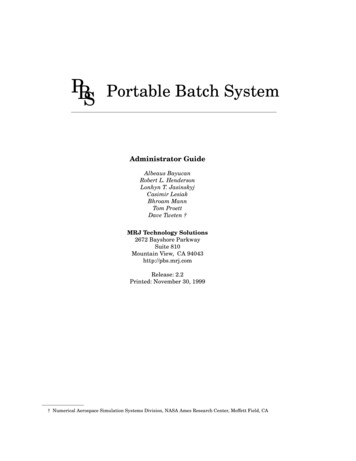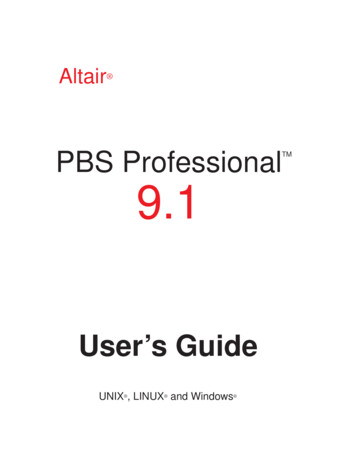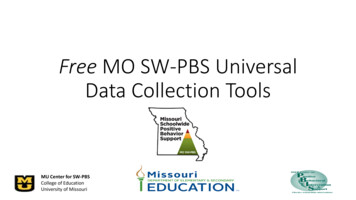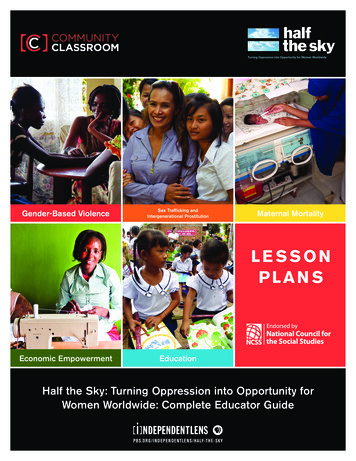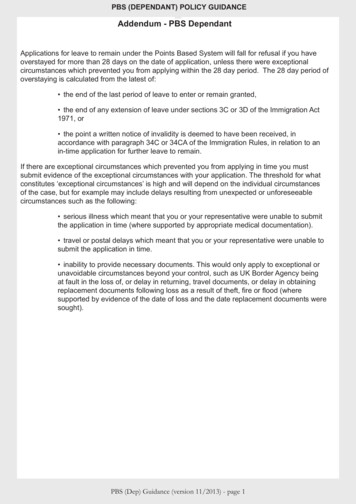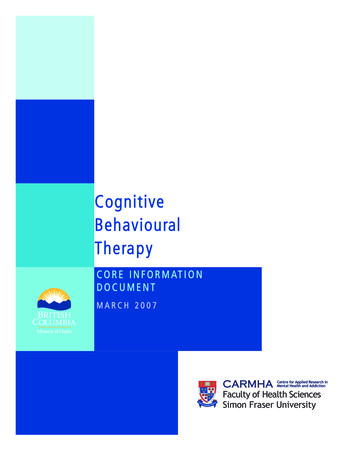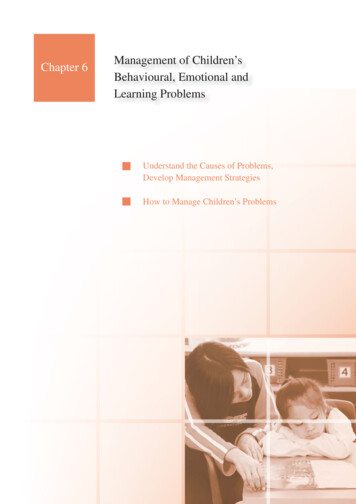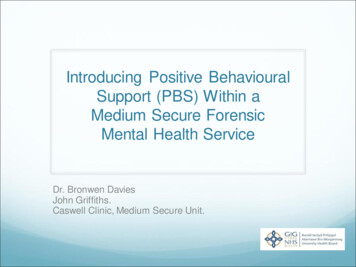
Transcription
Introducing Positive BehaviouralSupport (PBS) Within aMedium Secure ForensicMental Health ServiceDr. Bronwen DaviesJohn Griffiths.Caswell Clinic, Medium Secure Unit.
Caswell Clinic 5 Wards:- 61 service usersPenarth Ward:- Intensive Care Unit(Male). 8 beds Tenby Ward:- Admission/Assessment(Male). 14 beds Ogmore Ward:- Continuing CareRecovery. (male). 14 beds Cardigan Ward:- Continuing CareRecovery (Male only). 14 beds Newton Ward:- Admission &Assessment (Female). 11 beds
What is PBS? An understanding of a person’s behaviour is developed based onfunctional analysis, considering environmental triggers andreinforcing consequences. This is the basis for formulation andintervention. It is values led and promotes service user involvement. It focuses on prevention of challenging behaviour throughfeedback, skills training, altering or reducing triggers orreinforcements, and improving service user quality of life. It eliminates the use of punitive approaches. It has a long term focus- is developmental and can be service userdirected.
What is PBS? Reduction of challenging behaviour as a side effect of theintervention. The PBS model identifies early warning signs that challengingbehaviour may occur and suggests de-escalation and distractiontechniques prior to crisis management. Post incident support is outlined within the plan. The PBS plan is a live document and should change with apersons needs and wishes. Collaboration, empowerment and choice are central
PBS: The ModelCrisisManagementSecondary PreventionPrimary Prevention
Primary Prevention: LargestPart of the Plan Changing the environment Improving communication stylesand opportunities Increasing rates of access topreferred reinforcers Increasing rates of engagement Offering programmes of activities Modifying demands Addressing mental and physical Providing additional helphealth Improving carer confidence andcompetence Eliminating or modifying triggers Reinforcing pro-social behaviour Empowerment and choice Embedding disliked tasksbetween more preferred tasks Teaching skills e.g. Coping skills,social skills, general skills,functionally equivalent skills Positive role-modelling by carers
Secondary Prevention Active listening Stimulus change/ removal Prompting to use coping skills De-escalation Not ignoring as this may increase distress/ behaviour Strategic capitulation Diversion to reinforcing or compelling activities
Crisis Intervention Proxemics Breakaway Minimal physical intervention As required medication Post incident support Can be employed as advanced directives as promotedwithin policy
Why PBS at Caswell? High levels of challenging behaviour being experienced. Skills and knowledge existed within the service (clinical nursespecialist and psychologist). Value base attractive to clinical teams and service management. Recognition that more restrictive approaches were not working, orwere having a detrimental impact on therapeutic relationships. Approaches reactive to crisis resulting in longer term crisismanagement- not proactive or preventative. Little or no understanding of the causes and functions of challengingbehaviour by clinical staff.
Caswell PerspectivePrevious Approaches and Barriers RAID (Reinforce Appropriate, Implode Disruptive) trainingundertaken – circa 2005 for 1 ward – PICU. This is an approachbased on differential reinforcement- reinforcing pro-socialbehaviours and ignoring challenging behaviours. Only one ward trained and the skill base was dispersed acrossthe clinic as new wards opened. Inconsistent approach to functional analysis – often ABCcharts were not analysed or findings considered within careplans.
Caswell PerspectivePrevious Approaches and Barriers Review of Aggressive Incidents on PICU between January 2008 andJune 2010 undertaken. Triggers often not identified and Inconsistentand unstructured approaches to managing incidents identified. Littlethought or plan on how to prevent incidents occurring. PBS launched on PICU in 2011- PBS link nurses identified. Focus on ‘positive’ aspects of engagement and prevention of challengingbehaviours was appealing to clinicians. No cost issues due to in house expertise and knowledge. Links with Swansea University to Develop Practice Innovation Unitstatus. Published paper in “Mental Health Practice” (Griffiths and Wilcox, 2013).
Barriers Encountered Staff Attitude!!!! – Some staff believed we were rewarding challengingbehaviours, or they felt they were being ‘manipulated’ by the service users. Comments of “there must be a consequence to this”, “they shouldn’t beallowed to get away with this.”, “they have got to learn” Limitations of initial training: Focus only on one ward – service users and staff moved – dilution ofskills and knowledge. Lack of consistency in following care plans. Small service user group to focus on (8 max – not all on PBS plans). Ledto some inconsistent decisions and clinical team approaches. Feeling of “What next.” PBS seen as effective but somehow limited. Limited capacity of the psychologists to provide on-going training andsupport to ward staff.
Next Steps Survey PICU 2013. PICU staff surveyed on their views/ hopes/ and needs in relation toPBS. This highlighted: Staff were still trying to implement PBS within the area, however: Staff often felt excluded from writing the PBS plans and wanted more input in their development so they had a better understanding of them.There was a desire for more training- some staff had not received anywhilst others had only received parts of the training and not all of it. Thosethat had received training wanted to be updated to refresh their skills.Primary nurses wanted more support from other disciplines in promotinga PBS approach.There was a need for assessment tools that could be used to analysechallenging behaviours.There was a need to audit and evaluate the success of PBS plans.The approach adopted varied across the team, there was a need formore consistency and commitment to the PBS approach on the ward.
Where we are now!! Functional analysis tools have been introduced to complimentABC charts and are included in the training for qualified staff.These are: “Contextual Assessment Inventory” “Brief Behavioural Assessment Tool”- Smith and Nethell (2013) Service User Assessment Tool. Individual PBS plans developed (I-PBS) Currently there are eleven live plans. Two more underway in the men’s service. Three women identified for plans, we are beginning the process. I-PBS plan- developed within ABMUHB LD Services. Serviceusers perspective and narrative (written in first person). Serviceuser involvement central, all plans agreed with the service userbefore implementation.
Where we are now!! The PBS training and resources have been re-developed andprovided to nurses, OTs and psychologists. A full days training is being provided to qualified staff. Half a day to unqualified staff. To date 97% of R.N’s and 68% of HCSW’s, 100% OT’s and 83%psychologists across the clinic have had training. Staff from fellow disciplines (e.g. Medicine and social work) have alsoreceived training. Qualified staff being supervised/ supported through their first functionalanalysis and I-PBS plan. 10 staff have commenced Advanced Professional Diploma training in PBSand will become Behaviour Specialist upon completion of course.
Where we are now!! Current Challenges: Specialist Support Across the ClinicRotation of staff across the wards leaving clinical areas without a trainee behavioural specialistinsitu. Change Management:Scepticism by some staff although largely outweighed by positive responses. It does highlight thechallenges of implementing change and engaging staff in a fundamentally different approach tochallenging behaviour. Managing Expectations:Supporting staff to recognise when crisis management is the only option for managing imminentrisk of violence and realising this is not a failure of either PBS or team members. Resources:Only one person still maintaining responsibility for developing plans and supervising trainees, thiswill change when the specialists have completed their training. Communication:It can be difficult to organise effective communication to ensure PBS plans are known to all,particularly when service users move wards.
Governance: PBSImplementation Group Core PBS implementation group set up 2013- involving wardmanagers PICU Acute admissions ward, psychologists and headOT. Functions of the group: Review and agree assessment tools to be used within the clinic.Agree process of implementation of PBS within the clinic. Consider PBS training needs, review training and plan training datesto meet needs. Identify potential service users appropriate for PBS and monitor theirprogress. Develop service user information.
PBS ImplementationGroup cont. Evaluate the effectiveness of PBS and training within the clinic- agree process.Feed back process to service managers/ clinical governancesystems.Dissemination of results i.e. via publications and conferences.Network with learning disability specialist services within thehealth board and external forensic services implementing PBS.PBS Action Plan has been developed and reviewed continually.
Results of Training Evaluation Confidence: Confidence in working with challenging behaviour significantly increasedafter training for both qualified (t (29) -6.56, p 0.000) and unqualifiedstaff (t (27) -5.67, p 0.000). Qualified staff showed significant reductions in attributing the cause ofchallenging behaviour to the service user (p 0.001), attributingchallenging behaviour to the personal control of the service user((p 0.027) and considering challenging behaviour as more stable andchangeable (p 0.013). This was not replicated for unqualified staff. CHABA measures attributions for causality of challenging behaviour:Causes measured: Biomedical, learned, emotional, physicalenvironment, stimulation. All causal attributions increased significantlyfor qualified and unqualified members of staff, with the exception ofemotional attributions which increased only for qualified staff.
Results of PBS PlanEvaluation 12 plans evaluated pre- implementation and 3 monthlypost implementation Evaluated using the Challenging Behaviour Checklist(Harris et al. 1994) adapted for use within this service. Currently significant difference between baseline andlast measurement (z -3.297, p 0.001)
Frequency Pre and Post PBSIntervention70SU260SU3SU 450SU 5SU 640SU 7SU 830SU 920SU10SU1110SU12SU130BaselineTime 1Time 2Time 3time 4SU14
Results of PBS Qualitative Plan Evaluation:Service Users Experiences (n 10)Master ThemeSub ThemeNumber ofSU1. My PlanA- Understanding me / sharing my storyB- Good days, bad days, triggersC- My Involvement93102. How I understandPBSA- What it isB- Why MeC- AccessibilityD- An efficient summary88443. How PBS hashelped me; thebenefitsA- Reflecting on my behaviourB- Noticing and wanting change564. Making the PlanworkA- Staff fidelity to the model and planB- Keeping the plan aliveC- Implementation (barriers &suggestions)462
Next StepsRecommendations Options appraisal in relation to interim report underway.One behavioural specialist on each ward and clinical teams.Training days attended by all staff across the clinic.Development of a structured review process.Improve communication systems.Interim plan development for new admissions to PICU.Set up audit trail based on good practice framework.Disseminate and share outcomes via publications andconferences.
Take home messages: From our experience within the clinic the effectiveness of PBS isbased on a number of factors: Service user collaboration from the start. Multi-disciplinary involvement and commitment to PBS. A service wide commitment to embedding the value base of PBSwithin it’s practice, reducing the need for reactive strategies. Training of staff across the clinic in the principles of PBS On-going evaluation of effectiveness being fed back to clinicalteams and service user feedback being used to improveprocesses
Case Study Gwyn- age 26. Gwyn had history of poly substance misuse and petty offending tofund addiction. IQ in borderline range, limited social skills,aggressive assertion to get his needs met. Index offence- Unlawful wounding, assault occasioning actual bodilyharm- 3 assaults included in these charges. History of violentoffending 2005- 2013. Presented with paranoia and psychosis exacerbated by substancemisuse. Section 37/41 MHA.
Case Study Assessment – BBAT, CAI, client assessment. Important for hismotivation to be engaged in the process and set his own recoverygoals. Behaviours: Throwing things at people- kicked a ball at someone’s head Self harm- cutting arms (mainly in prison) Slamming doors Shouting and swearing at people Threatening to hurt others or damage the environment Refusing to do things/ non-compliance/ breaking clinic rules Anti-social- pro-criminal/ pro-violent attitude shared with peers “Egging on” others behaviours
Triggers:Case StudySlowFastPsychosis- particularlyparanoia and anxietyFemale/ inexperienced staffBoredomLarge groups of peersLack of confidence and lowself esteemMedication changes and sideeffectsBorderline IQWhen asked to do somethingnew or difficultRequests refused withoutexplanationAuthoritarian or sternapproach from staffBeing given correctivefeedback insensitivelyFeeling criticised- especiallyin front of peersHaving requests declined Maintaining functions: Escape/avoid difficult situations, acceptance andadmiration from peers, feeling less vulnerable.
Case Study Primary Prevention: Communication Strategies: Simplify language, no complicated or abstract terms,check understanding, rephrasing, provide rationale if say no/ make changes, usecalm friendly tone, give feedback sensitively and on a 1:1- not in front of peers etc. Social role modelling- giving feedback sensitively and showing appropriate ways tomanage social situations. Providing 1:1 sessions to discuss goals and progress Activity Timetable- more structure and distraction- preventing boredom. General skills- parenting skills, independent living skills- role modelling andbreaking skills down into smaller steps. Support to maintain drug abstinence- drug education and relapse prevention group. Differential reinforcement- offer praise and positive feedback when he walked awayfrom difficult situations and did not get involved, or asking staff for support Secondary Prevention and Crisis Management:Early indicators, distraction, validation of feelings, opportunity to talk to staff,give time and space to calm, prn, safe holds etc.
Case Study Evaluation- moved from PICU, acute then rehab within 3 month period Checklist for Challenging Behaviour:PrePostFrequency302Management Dif131Severity20 Qualitative feedback from Service User: “Helped me move to where I am today” “Clear to understand”
Thank You Any questions? Contact details: Bronwen.Davies2@wales.nhs.uk John.Griffiths@wales.nhs.uk
Feed back process to service managers/ clinical governance systems. Dissemination of results i.e. via publications and conferences. Network with learning disability specialist services within the health board and external forensic services implementing PBS. PBS Action Plan has been developed and reviewed continually.
